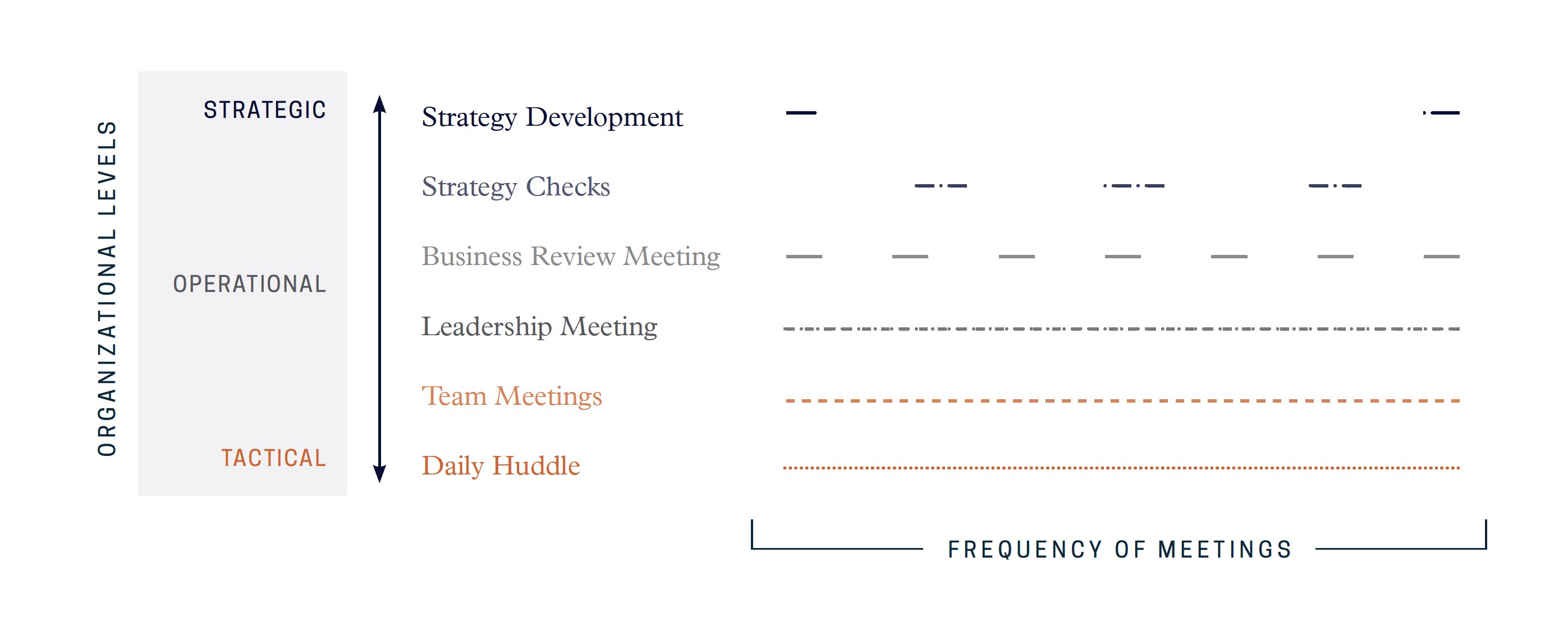Five Keys to Strategy Execution
Modern strategy development has been a muscle exercised by businesses for over sixty years. As such, most organizations have a good, or at least good enough, strategy to set them up for success. Few organizations, however, have the capability to execute that strategy effectively.
Execution is the great differentiator that separates high-potential from high-performing organizations, and that difference begins with senior leadership. Leadership teams spend months building a beautifully crafted strategy—often with the help of highly paid consultants—that lays out a compelling vision with concrete objectives. It’s then handed to their direct reports with the order to carry out the strategy. Easy enough, right? Months later, the organization is struggling, stakeholders are disappointed, only a few strategic actions have been completed, and the leadership team is left wondering, “What went wrong?”
There is a significant chasm between devising a strategy and executing a strategy. More often than not, senior leaders delegate the responsibility of closing that gulf to mid-level leaders who were not part of the strategy build and do not have the resources to execute the plan that has been laid out.
It is the leadership team’s job to create the conditions in which the strategy can be successfully executed, and that requires just as much, if not more, thoughtful planning as the crafting of the strategy in the first place. Below are five keys to ensuring you have set the conditions for successful strategy execution.
1. BE RUTHLESS: WIN BIG BY PRIORITIZING FROM DAY ONE
Where Leaders Fail
A strategy that does not prioritize the initiatives that need to be accomplished is no more than a “wish list.” Leaders often ambiguously state that all the critical tasks need to be done. That would be a fine practice if infinite time and resources were available and we existed in a world void of competition; however, we all know that is never the case. It is the leadership’s job to make the hard decisions on where to place their bets and to accept the consequences—for better or worse—of those choices.
How to Ruthlessly Prioritize
 It may sound simple, but you may or may not be surprised at how infrequently it actually occurs. Force-rank your strategic initiatives – put numbers to them – from highest to lowest impact to strategy actualization. Check your prioritization by going through an exercise with the leadership team to discuss what specific repercussions will happen to the organization if an initiative is not accomplished. When leaders set priorities, they often consider “what opportunity will this create if we complete this initiative.”
It may sound simple, but you may or may not be surprised at how infrequently it actually occurs. Force-rank your strategic initiatives – put numbers to them – from highest to lowest impact to strategy actualization. Check your prioritization by going through an exercise with the leadership team to discuss what specific repercussions will happen to the organization if an initiative is not accomplished. When leaders set priorities, they often consider “what opportunity will this create if we complete this initiative.”
While that is an important conversation, taking the opposite lens of “What risk will this pose if we fail to accomplish this initiative?” is far more important when it comes to strategy execution in a resource-constrained environment. If the criticality of an initiative is more severe than others, then it should be prioritized higher. Rearrange your priorities until they are in order of criticality, and then allocate your time, attention, and resources accordingly. These priorities should be recalibrated on an intentional cadence to confirm that they reflect the ever-present changes in your operating environment.
2. FIND THE LIMFACS: EXPOSE BOTTLENECKS AND UNCOVER HIDDEN DEPENDENCIES
Where Leaders Fail
Every strategy has critical choke points. No matter how motivated people are or how well-resourced the plan is, there are limiting factors (LIMFACs) that will throttle down the speed at which a strategy can be executed. Many leaders have a general sense of these bottlenecks and interdependencies but don’t take the time with their leadership teams to make them explicit so that they can be addressed or mitigated. Instead, too often it’s assumed that those actioning the strategy at lower levels of the organization will simply figure it out.
How to Uncover Interdependencies
Map out your interdependencies – draw them out, but don’t list them. The simple act of drawing out a map of which groups or individuals are connected to the execution of an initiative activates a different part of your brain, which may produce a realization that you or your team had previously missed. Once you have the map, connect with each of those interdependencies to determine (1) what competing priorities they have, (2) where this initiative falls on their list, and (3) what resource constraints they are operating under. Armed with this information, your leadership team can return to the strategy to identify potential vulnerabilities in the plan that need to be addressed before they become a major barrier to execution.
3. SET THE BEAT: MASTER YOUR TEAM’S OPERATING RHYTHM
Where Leaders Fail
The operating rhythm establishes the rhythmic beat of your organization, and it has one purpose and one purpose only—to enable the execution of the strategy at scale. We see that often times leaders and their organizations fall into legacy routines of how often they meet, who they speak with, and what information they share. They operate from familiarity and comfort rather than intentionality and outcomes. This breeds meeting bloat, wasted time, frustration, and lack of accountability when it comes to strategy execution. In short, the organization is “offbeat.”

However, even when leaders are “onbeat,” there is still the tendency to constrain dialogue around strategy to the upper echelon of the organization. There can be an unspoken bias that only senior leadership truly understands the complexity of the environment and, therefore, only the senior leadership should be involved in the discussion. Great leaders push against this tendency, opening the conversation to include a much wider net of stakeholders and proactively pushing information to the lower levels of the organization early and often. Without an effective operating rhythm, this wider distribution can be unwieldy and chaotic, but when leaders institute the right communication processes, systems, and behaviors at scale, they can accelerate execution. It takes an army to deliver on strategy, and activating that army starts with information flow.
How to Set the Beat
Your strategy should evolve to reflect material changes in your operating environment. And if your strategy has evolved, it is time to revisit your operating rhythm. Your cadence of information sharing should be based on the speed at which changes occur in your operating environment and impact the interdependency map you drew earlier. Determine (1) what information and resources those interdependencies need from you, (2) what information and resources you need from them, (3) how often the sharing of information and resources needs to happen to execute your strategy successfully, and (4) what form that sharing should take (collaboration forum, information automation, intelligent dashboards, etc.). The key is that one person must be responsible for keeping the organization on beat. If no one has accountability, the organization will slip back into the status quo, and your operating rhythm will quickly become a burden to execution rather than an accelerant.

4. ACCOUNTABILITY ON STEROIDS: TRACK WHAT MATTERS
Where Leaders Fail
There’s an old saying, “If everyone is responsible for feeding the dog, the dog starves.” Perhaps an addendum should be written, “And if no one is measuring how much food the dog gets, the dog gets fat.” Strategic initiatives are much the same. Either they are starved of attention and resources because no one is directly accountable for the results, or they are bloated by inefficient use of resources without any true metrics that allow leaders to make data-informed course corrections. In today’s world, telemetry abounds. Firms can measure many aspects of their business – from sensors on the manufacturing floor to detailed efficiency metrics in service firms. Determining how to measure progress becomes an obstacle when leaders get mired in all the ways they could measure, taking the focus off data and information that matters most to strategy actualization.
How to Track What Actually Matters
 Let’s assume you have identified one leader accountable for each initiative’s execution. Now, shift your focus with the end in mind. For every strategic initiative, clearly articulate what success should look like as a measurable outcome, then determine the specific results or observable changes that would signify this success. We call these our Measures of Effectiveness (MOEs) as they indicate whether your strategy achieves its intended purpose. Next, determine two to three leading indicators that will signal progress toward achieving these outcomes—these are your Measures of Performance (MOPs). To simplify the concept, think of visiting a doctor when you’re ill: taking your prescribed medicine represents your MOPs (the actions you’re tracking), while the medicine’s effectiveness in improving your health represents your MOEs (the ultimate result).
Let’s assume you have identified one leader accountable for each initiative’s execution. Now, shift your focus with the end in mind. For every strategic initiative, clearly articulate what success should look like as a measurable outcome, then determine the specific results or observable changes that would signify this success. We call these our Measures of Effectiveness (MOEs) as they indicate whether your strategy achieves its intended purpose. Next, determine two to three leading indicators that will signal progress toward achieving these outcomes—these are your Measures of Performance (MOPs). To simplify the concept, think of visiting a doctor when you’re ill: taking your prescribed medicine represents your MOPs (the actions you’re tracking), while the medicine’s effectiveness in improving your health represents your MOEs (the ultimate result).
Once these measures are defined, develop a comprehensive measurement plan to track and report on the selected measures. Determine how frequently this data needs to be collected and reported to the leadership team to enable quick, informed decisions in response to changing circumstances. Assign responsibility to a specific individual for gathering and synthesizing the data into a clear, actionable format. Consider investing in tools or systems that automate data collection and aggregation. Options for doing so abound these days. Digital dashboards, for instance, can streamline the process, allowing for more frequent updates with less manual effort. By focusing on clear measures, accountability, and efficient reporting, you can ensure your team is ubiquitously tracking what truly matters to drive success while ignoring all the noise.
5. STRESS-TEST YOUR STRATEGY: BREAK IT BEFORE IT BREAKS YOU
Where Leaders Fail

Due to inherent biases, organizations and leaders are systematically incapable of identifying their blind spots, challenging their assumptions, or assessing adversarial perspectives. We tell ourselves we can overcome our cognitive biases and “think outside of the box,” overcoming groupthink and hierarchy, but in reality, we lack the innate capability to do so. Simply put, we are bad at accurately grading our own homework. As a byproduct, leaders don’t imagine how initiatives can fail—and failure happens in ways they don’t anticipate. We frequently review a project or initiative after its completion, following an established process that reveals what went well, what went wrong, and what we could learn from the experience. However, these post-mortem type exercises belie the opportunity cost of alternative actions that could have improved the probability of success of the initiative or project.
How to Break Your Strategy Before It Breaks You
 To overcome these inexpungable biases, leaders require a liberating yet structured process that is semi-independent from the initiative itself. This process attempts to better understand the organization’s interests, intentions, and capabilities or those of competitors or clients.
To overcome these inexpungable biases, leaders require a liberating yet structured process that is semi-independent from the initiative itself. This process attempts to better understand the organization’s interests, intentions, and capabilities or those of competitors or clients.
Instead of waiting until the end of an initiative or project, leaders should conduct a Red Teaming exercise before execution to imagine how the initiative could go wrong, the impact these vulnerabilities could have on the successful outcome of the initiative, and the probability of these vulnerabilities happening. This allows leaders and teams to take a proactive stance on mitigating risks, thereby improving the probability of success of the initiative. Mitigation actions can be taken for the identified vulnerabilities, and contingency plans can be actioned for those assumptions that fail to get the initiative back on track. This is more than an exercise in managing risk; it is a forward-looking exercise for achieving success.
Conclusion
A perfect strategy that is imperfectly executed will fail. Successful leadership teams spend significantly more time and energy on the execution of the strategy than they do building it in the first place. As you enter the new year, put a leadership team offsite or a series of exercises on the calendar to focus on the five keys detailed above. You may be shocked at how much work is still left to be done to ensure your strategy will be executed, but if you take the time now to set the right conditions, you will also be shocked at year’s end with how much you have accomplished.





